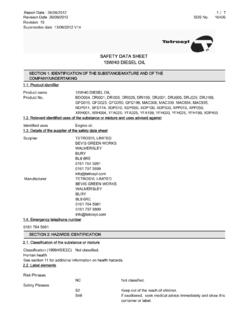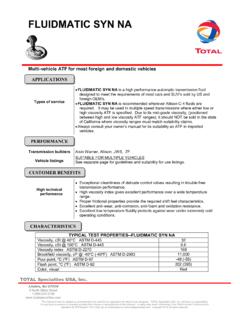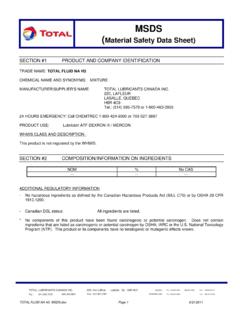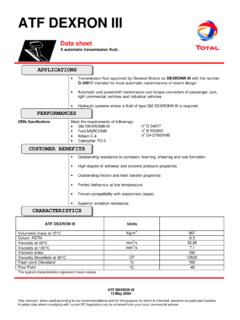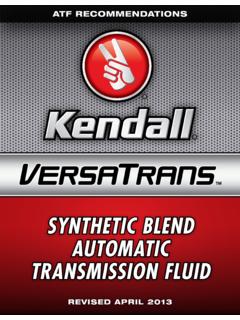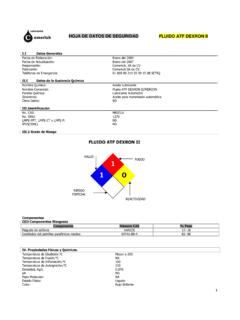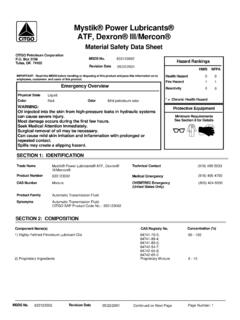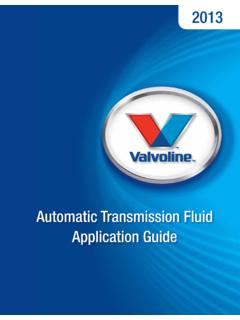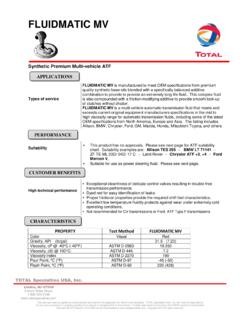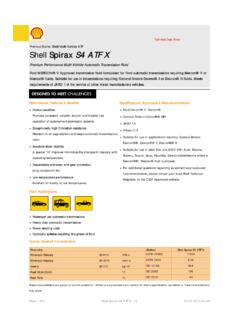Transcription of SAFETY DATA SHEET DEXRON III TRANSMISSION FLUID
1 Revision date: 28/01/2013 Revision: 10 Supersedes date: 05/10/2012 v9 SAFETY data SHEETDEXRON III TRANSMISSION FLUIDSECTION 1: Identification of the substance/mixture and of the Product identifierProduct nameDEXRON III TRANSMISSION FLUIDP roduct numberNBF500, NBF501, XTE100, XTE455, XTE500, Relevant identified uses of the substance or mixture and uses advised againstIdentified usesEngine Details of the supplier of the SAFETY data sheetSupplierTETROSYL LIMITEDBuryLancashireEnglandBL9 7NY0161 764 59810161 797 LIMITEDBuryLancashireEnglandBL9 7NY0161 764 59810161 797 Emergency telephone numberEmergency telephone+44 (0)161 764 5981 SECTION 2.
2 Hazards Classification of the substance or mixtureClassification (EC 1272/2008)Physical hazardsNot ClassifiedHealth hazardsNot ClassifiedEnvironmental hazardsAquatic Chronic 3 - Label elementsHazard statementsH412 Harmful to aquatic life with long lasting Contains 2-PROPANOL, 1-(TERT-DODECYLTHIO)-. May produce an date: 28/01/2013 Revision: 10 Supersedes date: 05/10/2012 v9 DEXRON III TRANSMISSION FLUIDP recautionary statementsP273 Avoid release to the Dispose of contents/ container in accordance with national If medical advice is needed, have product container or label at Keep out of reach of Other hazardsSECTION 3: Composition/information on MixturesDISTILLATES (PETROLEUM), HYDROTREATED LIGHTNAPHTHENIC.
3 <3% DMSO < number: 64742-53-6EC number: 265-156-6 REACH registration number: 01-2119480375-34-0000 ClassificationAsp. Tox. 1 - H3042-PROPANOL, 1-(TERT-DODECYLTHIO) <1%CAS number: 67124-09-8EC number: 266-582-5 REACH registration number: 01-2119953277-30-0000M factor (Acute) = 1M factor (Chronic) = 1 ClassificationSkin Sens. 1 - H317 Aquatic Acute 1 - H400 Aquatic Chronic 1 - < number: 108-88-3EC number: 203-625-9 REACH registration number: 01-2119471310-51-0000 ClassificationFlam. Liq. 2 - H225 Skin Irrit. 2 - H315 Repr. 2 - H361dSTOT SE 3 - H336 STOT RE 2 - H373 Asp.
4 Tox. 1 - H304 The full text for all hazard statements is displayed in Section 4: First aid Description of first aid measuresGeneral informationGet medical attention if any discomfort continues. Remove affected person from source ofcontamination. Move affected person to fresh air and keep warm and at rest in a positioncomfortable for spray/mist has been inhaled, proceed as follows. Move affected person to fresh air andkeep warm and at rest in a position comfortable for physician if larger quantity has been consumed. Rinse mouth thoroughly with date: 28/01/2013 Revision: 10 Supersedes date: 05/10/2012 v9 DEXRON III TRANSMISSION FLUIDSkin contactRemove contaminated clothing immediately and wash skin with soap and contactRinse immediately with plenty of water.
5 Remove any contact lenses and open eyelids wideapart. Continue to rinse for at least 15 minutes. Do not rub Most important symptoms and effects, both acute and delayedGeneral informationThe severity of the symptoms described will vary dependent on the concentration and thelength of exposure. Effects may be delayed. Keep affected person under cause an asthma-like shortness of breath. Vapours may cause headache, fatigue,dizziness and cause discomfort if swallowed. May cause stomach pain or vomiting. May cause nausea,headache, dizziness and contactProlonged or repeated contact with skin may cause irritation, redness and contactMay cause temporary eye Indication of any immediate medical attention and special treatment neededNotes for the doctorNo specific recommendations.
6 If in doubt, get medical attention 5: Firefighting Extinguishing mediaSuitable extinguishing mediaExtinguish with the following media: Foam, carbon dioxide or dry powder. Use fire-extinguishing media suitable for the surrounding extinguishingmediaDo not use water jet as an extinguisher, as this will spread the Special hazards arising from the substance or mixtureSpecific hazardsFire creates: Carbon monoxide (CO). Carbon dioxide (CO2). No unusual fire or explosionhazards combustionproductsThermal decomposition or combustion may liberate carbon oxides and other toxic gases orvapours.
7 Oxides of Advice for firefightersSpecial protective equipmentfor firefightersLeave danger zone 6: Accidental release Personal precautions, protective equipment and emergency proceduresPersonal precautionsFollow precautions for safe handling described in this SAFETY data SHEET . Avoid inhalation ofvapours. Avoid contact with eyes and prolonged skin contact. Provide adequate ventilation. Incase of spills, beware of slippery floors and Environmental precautionsEnvironmental precautionsAvoid or minimise the creation of any environmental contamination. Do not discharge intodrains or watercourses or onto the ground.
8 Collect and dispose of spillage as indicated inSection Methods and material for containment and cleaning up3/8 Revision date: 28/01/2013 Revision: 10 Supersedes date: 05/10/2012 v9 DEXRON III TRANSMISSION FLUIDM ethods for cleaning upStop leak if possible without risk. Eliminate all sources of ignition. No smoking, sparks, flamesor other sources of ignition near spillage. Provide adequate ventilation. Provide adequateventilation. Contain spillage with sand, earth or other suitable non-combustible material. Avoidthe spillage or runoff entering drains, sewers or watercourses.
9 Absorb spillage with non-combustible, absorbent material. Collect and place in suitable waste disposal containers andseal Reference to other sectionsReference to other sectionsWear protective clothing as described in Section 8 of this SAFETY data SHEET . Collect anddispose of spillage as indicated in Section 13. The product contains a substance which ishazardous to aquatic organisms and which may cause long term adverse effects in theaquatic environment. See Section 12 for additional information on ecological 7: Handling and Precautions for safe handlingUsage precautionsGood personal hygiene procedures should be implemented.
10 Wash hands and any othercontaminated areas of the body with soap and water before leaving the work site. Do not eat,drink or smoke when using the product. Avoid the formation of mists. Provide adequateventilation. Always remove oil with soap and water or skin cleaning agent, never use organicsolvents. Do not use oil-contaminated clothing or shoes, and do not put rags moistened withoil into Conditions for safe storage, including any incompatibilitiesStorage precautionsKeep containers upright. Store in tightly-closed, original Specific end use(s)Specific end use(s)The identified uses for this product are detailed in Section 8: Exposure Controls/personal Control parametersOccupational exposure limitsNo exposure limits known for ingredient(s).



